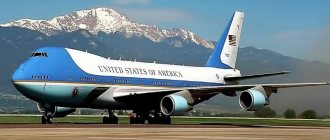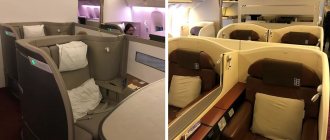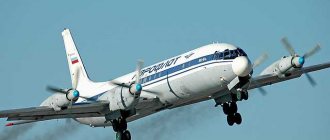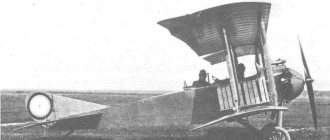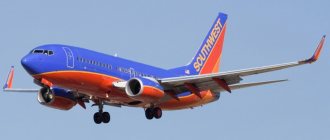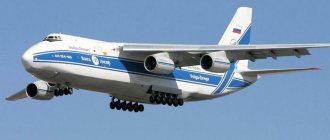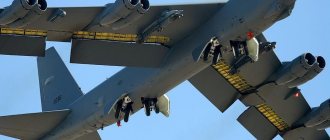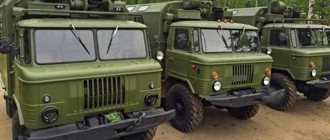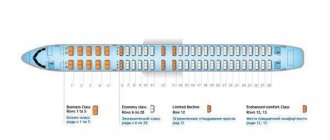Looking from below, it seems that these iron birds are weightless and simply float in the air. But if you find out how much the plane weighs, you will be very surprised. This can be hundreds of tons, and without taking into account the fuel supply, passengers and their numerous luggage.
Many people are puzzled why airlines so carefully monitor compliance with the permissible weight of luggage on the plane. It would seem that a few extra pounds will make a difference? Now multiply them by the number of passengers. This will result in a couple of additional tons, which, in a certain situation, can become critical.
Each aircraft has its own maximum take-off weight. This is its own weight, plus passengers and fuel. Accordingly, the smaller it is, the more comfortable the takeoff and landing. So, luggage weight restrictions exist for our own safety. Let's look at how much the most popular aircraft models used in commercial aviation weigh.
How much does luggage weigh on an airplane?
The long-awaited vacation is approaching.
A holiday destination has already been chosen, plane tickets have been purchased and a list of the “essential” things has been compiled - all that remains is to pack all the “goods” into bulky suitcases and board the snow-white liner at the appointed time. However, you should not take the entire contents of your wardrobe with you on a week-long vacation. The fact is that there are certain limits on baggage transportation set by many airlines. Therefore, before departure, you should ask what the permissible weight of luggage on the aircraft of the selected flight of this airline is.
Let's first define the types of personal cargo:
- Checked baggage is usually a suitcase that needs to be checked into the cargo hold of the aircraft.
- personal baggage is a small handbag that is allowed to be carried on board the aircraft. During the flight it is located on a shelf located above the passenger seat.
- personal items are not subject to weighing and do not belong to hand luggage (outerwear, umbrella, cane, laptop, video camera and camera).
- Duty-free purchases made at the airport or on board an airplane are also not included in the carry-on baggage category.
- baggage of non-standard format - this type includes strollers (children and wheelchairs) transported free of charge in excess of the norm. However, in such cases, you should make prior agreement with the company.
Free carriage by law - 2020 changes
Boeing 737 passenger plane
The legislation of the Russian Federation determines the standards for the carriage of hand luggage and baggage on board airliners of domestic companies. The standards are given in the text of the Order of the Ministry of Transport of the Russian Federation of 2007. The regulatory act underwent changes on January 14, 2022, which we will consider below.
Do not confuse luggage and hand luggage. The first is carried in the cargo compartment, the second in the cabin. The law stipulates that the minimum weight and dimensions of the package are set by the carrier.
When buying a plane ticket, check whether free luggage is included in the price. The law allows the sale of tickets without enabling this option. All you can count on in this case is free carry-on luggage weighing up to 5 kg.
Hand luggage means any items not included in the list of items prohibited for transportation in the cabin. Their dimensions and maximum weight are determined by the carrier.
What indicators are important
The technical documentation for each type of aircraft specifies two main weight indicators: for an empty aircraft and various take-off indices that determine flight stability. There is a strictly defined operating weight, which includes the weight of the airliners themselves with built-in equipment, the weight of the on-board catering, as well as the weight of the crew members. When adding the weight of luggage and fuel reserves to this indicator, the taxiing (parking) weight of the aircraft is calculated. Take-off weight - the maximum possible number of tons at which the aircraft is able to reach the speed required for take-off, is obtained by subtracting the weight of fuel for taxiing from the parking weight. It is worth noting that these are maximum figures; the actual weight of the aircraft in various modes is influenced by weather conditions, runway characteristics and a number of other factors.
Passengers are not yet forced to weigh themselves. Although for small aircraft flying short distances, every kilogram is critical, and passengers are weighed along with their luggage. Therefore, for calculations, average weights are taken: 86 kg per passenger (in the cold season a little more due to outerwear) and 13 kg per piece of hand luggage. The maximum possible weight of passengers' luggage is also very important, since only 1-2 kilograms of excess weight per suitcase results in excess cargo for the entire airliner, which in some cases can lead to emergency situations in flight. However, this is not the heaviest component of the take-off mass, but only a tenth of it.
Passenger luggage is not the most significant part of the aircraft's weight
Most of it is the aviation fuel required for flight - about one third.
Aircraft designers are trying in every way to reduce the dead weight of the aircraft by using lighter structural materials for efficient commercial use of airliners (i.e., transporting more passengers in one flight). At the same time, an increase in the carrying capacity and capacity of an aircraft entails an increase in its dimensions.
Baggage and its features
On an airplane, unlike a car or train, the weight of luggage is extremely important, because it affects the flight characteristics. When asking the question of how much an airplane weighs, one cannot consider it without focusing on the passengers' belongings. You should immediately understand that if you go on vacation or a business trip, you will not be able to take as many things as you want. Each airline has its own luggage weight limits, which in turn are justified by the take-off weight of the aircraft itself. Always ask yourself this question in advance, so that later when boarding you don’t have to think about where to put things that don’t fit. In addition, each class usually has a different limit. There are the following types of personal items on an airplane:
- baggage for check-in, which is checked into the cargo hold of the aircraft;
- hand luggage is a bag that you can take on board. Usually this is a backpack with a laptop and documents;
- personal items are not weighed and do not belong to any of the categories, for example, a cane, outerwear, an umbrella;
- purchases in the duty-free area, they are considered hand luggage;
- non-standard luggage, for example, wheelchairs, children's strollers. They do not count towards weight.
Different models - different weights
It is worth understanding that in the case of an airplane, it is not the weight itself that is important, but its take-off mass. This term means an indicator that includes the sum of the weight of the car itself, its fuel and passengers with things on board. This value must absolutely not be exceeded. This is why you may notice airport staff carefully checking the plane before departure. Last but not least, attention is paid to weight parameters. This can also explain why there are such strict limits on luggage, the number of bags, and so on.
Boeing is a very spacious aircraft. Today, 75% of passenger ships on the market are from this company. If we talk about the Boeing 747, then it is a double-deck aircraft with a wide fuselage. There are several interpretations of this line, but all of them are mainly designed for long range. The shape of this aircraft is very recognizable due to the peculiar elevation in the front part. Before the release of this aircraft, the Boeing 737, which is still in use, was very popular.
Boeing 747 weight
The Boeing 747 passenger aircraft has rightfully led the ranking of the largest and heaviest airliners for transcontinental flights for thirty years. Its first flight took place back in 1969, and since then it has been operated by all the world's major airlines. The plane's crew consists of two people.
It can fly up to 15,000 km without refueling at a maximum speed of 1,102 km/h with six hundred passengers on board. There is a unique record in the history of the Boeing 747: during the fighting in Ethiopia in 1991 (Operation Solomon), 1,112 Ethiopian Jews were transported to Israel and saved on board the aircraft.
The question inevitably arises - how much the plane itself weighs, and what is its maximum take-off weight. With a length of 76.4 meters and a wingspan of 68.5 m, an empty Boeing 747 weighs, taking into account the amount of fuel filled, between 162-215 tons. The maximum permissible take-off weight of modifications is given in the table:
| Boeing 747 modification | Maximum take-off weight, t | |
| 1 | 747-100 | 340 |
| 2 | 747-200V | 378 |
| 3 | 747- 300V | 378 |
| 4 | 747-400 | 397 |
| 5 | 747-400ER | 412 |
| 6 | 747-8 | 442 |
This airliner model also “distinguished itself” in that the Space Shuttle was transported to the cosmodrome on board the Boeing 747.
Specifications
How much does world of tanks weigh?
The operational and technical characteristics of the Boeing 737 have undergone the most significant changes with each new generation.
Original
| Type | 737-100 | 737-200 |
| Length, m | 28,63 | 30,53 |
| Wingspan, m | 28,35 | |
| Fuselage width, m | 3,76 | |
| Cabin width, m | 3,54 | |
| Cabin height, m | 2,19 | 2,11 |
| Maximum take-off weight, kg | 43 998 | 45 359 |
| Cruising speed, km/h | 817 | |
| Engines | P&W JT8D-7 | P&W JT8D-9/9A |
| Maximum flight altitude, m | 10 670 | |
| Run length, m | 1290 | 2058 |
| Fuel capacity, l | 10 758 | 10 515 |
Classic
| Type | 737-300 | 737-400 | 737-500 |
| Length, m | 33,25 | 36,40 | 31,01 |
| Wingspan, m | 28,88 | ||
| Fuselage width, m | 3,76 | ||
| Cabin width, m | 3,54 | ||
| Cabin height, m | 2,20 | ||
| Maximum take-off weight, kg | 56 472 | 62 823 | 52 390 |
| Cruising speed, km/h | 807 | ||
| Engines | CFM56-3B1 | CFM56-3B2 | CFM56-3B1 |
| Maximum flight altitude, m | 10 700 | 11 300 | 11 300 |
| Run length, m | 2012 | 2356 | 1860 |
| Fuel capacity, l | 20 102 |
New Generation
| Type | 737-600 | 737-700 | 737-800 | 737-900 | 737-900ER |
| Length, m | 31,24 | 33,63 | 39,47 | 42,11 | |
| Wingspan, m | 34,32 | ||||
| Fuselage width, m | 3,76 | ||||
| Cabin width, m | 3,54 | ||||
| Cabin height, m | 2,20 | ||||
| Maximum take-off weight, kg | 56 245 | 70 080 | 79 015 | 74 389 | |
| Cruising speed, km/h | 852 | ||||
| Engines | CFM56-7B18 CFM56-7B20 CFM56-7B22 | CFM56-7B20 CFM56-7B22 CFM56-7B24 CFM56-7B26 CFM56-7B27 | CFM56-7B24 CFM56-7B26 CFM56-7B27 | ||
| Maximum flight altitude, m | 12 500 | ||||
| Run length, m | 1799 | 1677 | 2241 | 2408 | 2450 |
| Fuel capacity, l | 20 894 |
MAX
| Type | 737 MAX 7 | 737 MAX 8 | 737 MAX 9 |
| Length, m | 33,7 | 39,5 | 42,2 |
| Wingspan, m | 35,9 | ||
| Height, m | 12,3 | ||
| Cruising speed, km/h | 842 | ||
| Maximum take-off weight, kg | 72 303 | 82 191 | 88 314 |
| Engines | CFM International LEAP-1B |
How much do different brands of airliners weigh?
The modern aviation industry produces a large number of aircraft of different brands and their modifications. For calculations, long-haul American Boeings, Airbuses from Europe and Russian (Soviet) specifications are used.
So, how much does a Boeing plane weigh? The measured weight characteristics of most models are shown in the table (maximum take-off weight values are indicated).
Boeing aircraft weight
Attention: The internal data of table “56” is corrupted!
How much an aircraft weighs depends on the model, series and modification (during modernization, for example, the fuselage is shortened, which makes it possible to increase the flight range and reduce the dead weight of the aircraft).
The empty weight (with built-in equipment) of the aircraft is:
- for model 737 – 27-45 tons;
- for model 767 – 80-103 tons;
- for model 747 – 162-215 tons.
The heaviest passenger aircraft among the Boeing family is rightfully considered the double-deck Boeing 747 800 - its capacity is 660 passengers with luggage, its flight range without additional refueling exceeds 14 thousand km at a speed of about a thousand km per hour. The operating weight (empty aircraft) is 162-215 tons, the maximum take-off weight is determined to be 440 tons.
The heaviest among Boeings is the double-deck 747-80.
Many air carriers fly European-made Airbus A380 aircraft. It is they, and not the popular Boeings, that are considered the largest passenger aircraft operated in commercial aviation. This giant aircraft, more than 70 meters long, has a double-deck layout and can accommodate between 555 and 850 travelers. The weight of an empty plane is already amazing.
Operating weight of Airbus A380 model aircraft
Attention: The internal data of table “57” is corrupted!
The maximum takeoff weight of Airbus aircraft ranges from 560 to 590 tons.
Airbus A380 aircraft are the largest passenger airliners
Among passenger airliners of Soviet and Russian production, the most popular were the Tu-154 in various modifications. Currently, the TU-204 has become the most powerful and popular airliner. The weight characteristics of Russian aircraft are shown in the table below.
TU-204 is the heaviest Russian passenger airliner
Weight of TU model aircraft
Attention: The internal data of table “58” is corrupted!
How an airplane takes off
Before we find out at what speed the airliner takes off, let’s define what is called takeoff.
After the start of movement (taxiing, taxiing), the aircraft takes place on the runway (runway). Takeoff is movement along the runway, lifting off the ground and rising to the transition altitude. The takeoff of the ship occurs due to lifting force. As soon as this figure exceeds the weight of the aircraft, it will lift off the ground. What speed the plane will need during takeoff is determined by the design of the airliner. The indicator is also influenced by weight and loading, as well as other features of the vessel. Flaps and slats, which are part of the wing, regulate their load-bearing properties.
Takeoff types
To ensure lift-off from the ground, the engines operate in a special take-off mode, which lasts several minutes. This is the most difficult part of a pilot's job to manage. Takeoffs vary in technique and are of the following types:
- Off the brakes. The pilot allows time for the engine to reach maximum speed, while holding the aircraft on the brakes. When the desired value is reached, the brake is released and the run-up begins.
- Short delay on the runway. The ship stops for a short time, does not stand waiting for power to gain power, and immediately begins to move. The engines accelerate to the desired speed right on the runway. This technique can be implemented on a long runway.
In congested runway conditions, pilots sometimes have to take off without stopping at all (rolling start). The ship is transferred to takeoff mode when moving from the taxiway to the runway.
At what speed does it take off?
The type of aircraft determines at what speed a passenger plane takes off. For different models, optimal values have been determined to ensure vessel lift-off:
| Liner type | Speed (km/h) |
| Boeing 747 | 270 |
| "Tu-154" | 215 |
| Airbus A380 | 267 |
| "Yak-40" | 180 |
On average, modern passenger aircraft need to reach a speed of 230-250 km/h to take off. The indicator varies slightly depending on weather conditions and other characteristics. The professionalism and qualifications of the pilot are especially evident during the take-off phase.
The nuances of getting off the ground
Piloting skill consists of the ability to adjust take-off actions prescribed in the regulations, depending on external conditions, weather conditions and runway characteristics. Professionals should take into account the following nuances:
- runway length – on a short runway, preliminary engine acceleration is required;
- wind speed and direction, maximum gust value;
- air humidity and temperature;
- precipitation - changes the condition of the runway and the aircraft;
- atmospheric pressure indicators.
Speed adjustment is possible within 10-15 km/h and is selected by the pilot based on experience. Another important nuance is the need to reduce engine noise if it is located near residential buildings.
How fast does a Boeing 737 take off?
Passengers are particularly interested in the popular aircraft model, the Boeing 737. Take-off features of the aircraft:
- before takeoff, the engines are brought to a speed of 800-810 rpm;
- the airliner takes off, reaches a speed of 180-185 km, after deflecting the flaps, the nose rises;
- The takeoff speed of a Boeing 737 aircraft is 220 km; before reaching this value, the airliner travels on the ground on two wheels.
Then the airliner smoothly goes into the sky, completes takeoff and begins to climb.
Representatives of the 777 family
To designate the types of aircraft of this family, two characteristics are taken as a basis - fuselage length and range. The first of these determines how much cargo and passengers the aircraft can carry. The released versions of the 777-200 are the main types, and the 777-300 was developed in 1998 as an extended version.
If we consider flight range, then aircraft are divided into three groups or segments:
- A - up to 4200 nautical miles;
- B - up to 6600;
- C - up to 7800.
Boeing 777-200
This was the first aircraft model for segment A. It was created primarily for flights within the United States.
Boeing 777-200.
Boeing 777-200ER
The letters ER stand for Extended Range, which means “increased range” in English. From the name it is clear for what purpose it was developed. It can take more fuel. Capable of transporting heavy loads, up to hundreds of tons.
Boeing 777-200ER.
He set a record when he was able to fly on one engine for 177 minutes. No passenger airliner in the world could do this except Boeing!
Boeing 777-200LR
The added letters have the meaning Longer Range or greater range. It can fly to almost any, even the most remote airport in the world. It was specially designed for very long flights.
Boeing 777-200LR.
It has three fuel tanks, and it can take even more cargo on board . Its other features are the beveled wingtips. Its landing gear was updated and the airframe was strengthened.
Boeing 777-300
This is a longer model designed to replace the 747-100 and 747-200 variants. It differs from these aircraft in terms of fuel consumption and other materials.
Boeing 777-300.
Boeing 777-300ER
The two additional letters indicate that the aircraft is capable of flying longer distances. Its wingtips are beveled and elongated. The front pillar is strengthened. There are additional fuel tanks. This model's engines are superior in power to all others installed on aircraft.
Boeing 777-300ER.
Boeing 777-Freighter
This is the aircraft for transporting cargo in this family. It is capable of carrying almost 103 tons and can fly over distances of up to 9,047 km .
Boeing 777-Freighter.
Boeing 777X
In 2013, Boeing began developing this new model. It has not yet been put into mass production, but it is planned to do so by 2022 . It will be a very large but economical aircraft.
Its capacity will be 353 passengers. It will be longer than previous models. It is planned to change the wing twist and fairings in order to increase the aerodynamic characteristics of the aircraft. This will give it an advantage over all other airliners in the world.
Background to the Boeing 747
In the early 1960s, the world began to actively develop in terms of trade, large, large-scale air transportation was needed. The predecessor of the Boeing 747, the Boeing 707, could no longer cope with the volume of traffic. The flow of people wishing to fly quickly and comfortably increased every day, Boeing designers began to develop an analogue.
Joe Sutter in 1965 was the main developer who explored the consumer market as much as possible. After his research, he was the senior designer in charge of the Boeing 747. In those years, there was no bet on passenger transportation; inventors dreamed of sonic airplanes. Therefore, from the very beginning, the Boeing 747 was a cargo aircraft and only then a cargo-passenger aircraft. The designers designed all the aircraft as cargo planes, and this is precisely what they focused on. They freed up space as much as possible, and even moved the cockpits to accommodate more cargo.
Joe Sutter
In 1966, Boeing designers first showed a mock-up of a new aircraft labeled 747. In its original form, the aircraft had two decks, but many problems arose with this design. Soon an option was proposed: to make it in the form of a capsule, enlarging the sides. After the final version was presented, an order was received for the production of the Boeing 747 from PanAm in the amount of 25 units.
This company made some changes to the design of the aircraft, thanks to it the length of the wings and the design of the landing gear were changed, and it was also decided to increase the weight to 308,443 kilograms.
The most popular documents in the section
GOST R 52745-2007 Integrated quality control system. Control of materials used in the manufacture of aircraft products
Guidelines for freight transportation on domestic routes of the USSR
Guidelines for freight transportation on domestic routes of the USSR
GOST R EN 9100-2011 Quality management systems for organizations in the aviation and defense industries. Requirements
MU 2.6.1.1193-03 Radiation monitoring of aircraft contamination and determination of dose rate of ionizing radiation from radiation sources
OST 1.02776-2001 Technical operation of aviation equipment according to condition. Basic provisions
GOST 23718-93 Passenger and transport airplanes and helicopters. Permissible vibration levels in cabins and flight decks and vibration measurement methods
RD 50-25645.325-89 Guidelines. Artificial Earth satellites. Basic coordinate systems
OST 1.00370-96 AXIS. Metrological support of aviation equipment products. Basic provisions
OST 1 00763-75 External doors of passenger aircraft. General technical requirements
Buy OST 1 00763-75 - a paper document with a hologram and blue seals. more details
We have been distributing regulatory documents since 1999. We punch checks, pay taxes, accept all legal forms of payment without additional interest. Our clients are protected by law. LLC "CNTI Normocontrol"
Our prices are lower than other places because we work directly with document providers.
Delivery methods
Applies to external entrance and service doors of passenger aircraft.
| Date of introduction | 01.07.1976 |
| Added to the database | 01.09.2013 |
| Update | 01.02.2020 |
Organizations:
For free
download this document in PDF format, support our site and click the button:
Inv. Duplicate No. Literary revision. 1 2__3
Inv. No. signed___2574_ No. name. e * 59 8589 10549
What does your class affect?
It is not enough to know the weight of a passenger plane; you need to understand in which class you will be sitting. This affects not only the comfort in the cabin, the supply of drinks and food, but also the permissible weight of luggage. Here are the rules that are supported by most companies in the world:
- in economy class you can carry luggage weighing up to 23 kilograms;
- in business class, weight should not exceed 32 kilograms;
- in first grade the weight reaches 40 kilograms.
Speaking of what you take on board, you can take a bag weighing up to 7 kg in economy class, and up to 12 kg in other cases. If you are traveling with a child who is no more than two years old, then an additional 10 kilograms are issued for him, but for older children the same rules apply as for adults. In general, regulations may vary from airline to airline. Some carriers agree to take overweight luggage, but you will have to pay a fine for each extra kilogram. Others refuse to deal with the advantage at all. There are also various size restrictions. For example, in first class luggage can take no more than 203 centimeters, in economy class - 160 centimeters.
Transportation of non-standard luggage is decided individually with the company's employees. There are also rules for animals. Small dogs and cats can often be taken on board. Some companies have a place for them in the cabin. This means that you won’t be able to carry them by hand. Large animals cannot escape the luggage compartment. In addition, they must travel in special cages or animal bags that are protected from leakage and have good ventilation. Of course, this situation is stressful for the owners, but clear rules are rarely violated, so you need to prepare your pet as much as possible for the flight.
Modifications of the An-124 Ruslan aircraft
The first modified model of the vessel was released back in 1992. It was no longer intended for military purposes, so special equipment for military equipment and landing forces was removed. In addition, the radio navigation system, cargo compartment, crew compartment and the ship's engines underwent changes. The model was intended for large passenger transport and was named An-124-100 Ruslan.
Technical characteristics of An-124-100:
- The length, height of the vessel and wingspan remained unchanged (69 meters, 73 meters and 21 meters, respectively).
- The empty weight of the vessel decreased to 173 tons.
- The maximum carrying capacity dropped to 120 tons.
- The maximum fuel weight also became smaller - 212 tons.
This modification of the Ruslan aircraft retained its maximum speed. But the cruising speed has increased significantly - 800-850 km/h.
The An-124-100 Ruslan aircraft has a sad reputation. It was this model that crashed on February 6, 1997 in Irkutsk. The plane crashed immediately after takeoff. The cause of the plane crash is believed to be the failure of three engines at once. The ship crashed onto residential buildings, causing the number of casualties to increase significantly.
Specifications
The very first test flights showed that the Antonov Design Bureau had designed and built a unique aircraft, which to this day no foreign heavy aircraft has been able to surpass in dozens of technical parameters.
This is confirmed by hundreds of aviation world records set by Ruslan at the most popular foreign aviation shows and during days of hard daily work.
The main modification of the aircraft was designed according to the following technical specifications:
- Number and composition of the crew - 8
2 pilots, navigator, 2 flight engineers, flight radio operator, 2 loading and unloading system operators; - number of passengers – 28
7 – shift crew, 21 – service personnel. Depending on the modification and purpose of the aircraft, the crew composition may be changed. - Glider: length – 69.1 m, height – 21.08 m, wingspan – 73.3 m, wing area 628 sq.m.
- The main power plant is 4 turbojet 2-circuit engines D-18T designed by Progress Design Bureau, Zaporozhye. Chief designer - V.A. Lotarev. Total takeoff thrust 4 x 23430 kgf.
- Auxiliary power unit for air launch of the main propulsion system - 2 TA-12 gas turbine engines designed by JSC NPP Aerosila.
The design of the aircraft landing gear is multi-supported and consists of 24 wheels. The An-124 is the only heavy transport aircraft in the world capable of taking off and landing from unpaved airfields.
Carrying capacity, aircraft weight
The aircraft is designed to handle extreme loads.
A loaded An-124 weighs 178.4 tons. The maximum fuel mass in tanks located in the wings is 212.35 kg. In a cargo compartment with a length of 36.5 m, a width of 6.4 m and a height of 4.4 m and a total volume of 1050 cubic meters, Ruslan can transport by air a maximum load of 120 tons. Two identical cargo hatches - rear and front, have a length of 6.4 m and a height of 4.4 m.
The take-off weight of a fully loaded and refueled aircraft is enormous - 392 tons. Only one aircraft exceeded the weight and size parameters of the Ruslan - the An-225 Mriya, designed on its basis.
Advantages of AN-225
When it was ready, there was no longer any need to transport parts of the Buran. Only once did he transport it for the air show in 1989 .
With a short period of its use, it managed to achieve a number of significant records. For example, he transported the largest amount of cargo in the entire history of aviation - almost 157 tons.
In 2009, he was included in the Guinness Book of Records, as he was able to transport a monocargo with a total weight of 188 tons .
In general, this model has almost 250 different records around the world. The aircraft had a number of significant advantages.
Reconstruction of AN-225.
- First of all, the ability to transport large loads with a total weight of 250 tons . For example, 50 cars in one flight or turbines and generators.
- Secondly, it is the transportation of cargo up to 200 tons during intracontinental flights , without transfers. And for intercontinental ones - up to 150 tons .
- Thirdly, on the outside of the fuselage there is the possibility of attaching various cargoes up to 200 tons .
General information about the gravity of the airliner
People who have flown at least once know about on board. Here, airlines strictly monitor the number of luggage customers have, weighing things before boarding. Moreover, such actions are important for flight safety - after all, exceeding the permissible weight criteria is fraught with a decrease in flight comfort and can even lead to a crash.
A successful aerodynamic shape creates a visual effect of light aircraft
Therefore, airline workers try to ensure that the final weight of a passenger aircraft falls within the maximum norms inherent in a particular modification.
For pilots and aircraft designers, the term “aircraft take-off weight” is known. This definition means the total load on board, including the weight of the aircraft, people, luggage and fuel required for the flight. After all, this criterion determines the aerodynamic performance of the car. Therefore, when designing such mechanisms, developers reduce the aircraft’s own weight to a minimum.
Strict control of luggage weight is a consequence of the inadmissibility of exceeding the maximum take-off weight of the aircraft
True, the dimensions of a modern passenger aircraft require a significant mass. The Boeing 737 airliner weighs 49–70 tons, depending on the modification. Moreover, the weight of an empty plane is half the permissible values for takeoff.
Remember , aviators set the maximum value for both the required volume of fuel and a certain number of passenger and cargo seats. The weight parameters of the body are reduced due to the use of light metals for the fuselage structure and individual elements of the power plant.
Today, the task of the world's designers is to find new compounds that will reduce the dead weight of aircraft . These actions will increase the number of passengers and luggage on board. Let's take a closer look at how much a passenger plane weighs. As an example, let’s take today’s popular series for transporting travelers.
About the history of the liner
In the 70s of the last century, the company faced a serious problem in updating outdated models and creating aircraft that could compete with Airbuses.
Its prototypes were the Boeing 767 and 747 . If you look at the photo of the Boeing 777, you will notice that it is similar to these models.
When creating the aircraft, the opinions of the passengers themselves were taken into account, which is why it became the most consumer successful in the history of the company. It was completely developed on a computer and assembled on it. There are simply no paper drawings of this aircraft. This is also the reason why many production errors were avoided.
In the early 90s, Boeing began to design. The first company to use it is United Airlines. She started using it on her flights 5 years later .
Boeing 777 from Emirates.
The company with the most Boeing 777 models in its fleet is Emirates. In 2012, it received the 1000th, which joined the 102 aircraft then in the company's fleet.
Today, the 777LR is the aircraft that is capable of covering the longest distances.
Deciding on the criteria
Considering that flights involve the aircraft overcoming the force of gravity, the gravity indicators of a loaded airliner are extremely important. It’s not for nothing that the technical description of each model contains two values: empty weight and take-off indices. The last criterion plays an important role for the smooth flow of air travel.
The take-off weight of the board also includes a commercial component - the number of seats for passengers and luggage
Since the classification of airliners involves a variety of modifications for flights, there are machines for long-haul travel and local lines. Moreover, the gradations of systematization imply an accurate calculation of the weight of the airliner, adapted for long-distance flights. Modern air carriers prefer to use American Boeing, European Airbus and aircraft produced by the USSR - Tu for such purposes.
Note that when ordering a specific model, airlines also focus on the commercial weight that the airliner is capable of lifting. After all, it is this criterion that determines the degree of profitability of the flight.
As you can see, such a significant factor is reflected in the demand for specific models, since the maximum permissible take-off weight requires a combination of several values. Designers are trying to achieve an optimal balance of the weight of an empty ship with the volume of fuel tanks and the reserve of the liner, which is used for commerce. This task is complicated by the ability of the aircraft to take off - after all, it is also determined by the weight of the aircraft.
General information about the weight of aircraft
The visual effect of the airliner's lightness is created thanks to its successful aerodynamic shape. However, everyone who has flown by plane at least once in their life has encountered the rules for transporting baggage.
Airlines strictly monitor the weight of the client's luggage, weighing things before letting the passenger board the plane. Such strictness is due to the need to ensure the safety of passengers - exceeding the take-off maximum can both affect the comfort of the flight and lead to an airliner crash.
The term “aircraft take-off weight” itself is the totality of the load on board, which includes the initial weight of the aircraft, the weight of passengers and their luggage, as well as the weight of the fuel required for the flight.
The take-off weight of the airliner directly affects the aerodynamic characteristics of the aircraft, which is very important for a comfortable and safe flight. Therefore, aircraft designers strive to reduce the initial mass of the aircraft to a minimum.
However, the dimensions of modern aircraft require a significant initial mass - the famous Boeing 737 can weigh from 49 to 70 tons, depending on the specific modification of the model. The weight of an empty aircraft is usually two times lower than the maximum permissible take-off performance.
Light initial mass is achieved by using light metals in the manufacture of the fuselage, as well as in individual elements of the power plant.
Boeing weight
Let's first consider the most popular model - Boeing. 3/4 of the world's airlines use these airliners. This is due to their capacity and reliability. The following modifications of this airliner are most often used on the modern market: 737, 747 and 767.
Modifications 737100 and 737200 began to be produced back in the 1960s. Although model 737100 was not the most successful solution, it was these two models that laid the foundation for this popular series.
The empty weight of the Boeing 737100 was 29,600 kilograms, and the maximum take-off weight was 52,400 kilograms and 58,100 kilograms. The latest development, the Boeing 737800, developed on the basis of the 737400, has a mass of 41,400 kilograms and a maximum permissible take-off index of 79,000 kilograms.
A recent development, the Boeing 767 400ER, has amazing characteristics - the length of the side reaches 64.1 meters, while the weight of the empty airliner is 103,870 kilograms. The maximum permissible take-off weight in this airliner reaches 204,120 kilograms. Thus, an airline operating this aircraft can afford a payload of 49,000 kilograms.
Many people are interested in knowing the weight of the Boeing 747 model, which is striking in its size. The empty weight of this aircraft, depending on the modification, ranges from 141,900 kilograms to 167,000 kilograms. The maximum permissible take-off weight of this aircraft can reach 316 tons.
Airbus aircraft weight
These airliners, produced by a European holding company, are one of the main competitors of the famous Boeing. Their modifications are intended for medium-haul and long-haul flights. The heaviest aircraft among them is the well-known Airbus 380.
Various modifications from this series are the most spacious aircraft with the largest weight. However, they are leaders not only in these characteristics - it is noteworthy that the Airbus 380 is also the fastest airliner among subsonic aircraft.
Weights of various modifications of the empty side of the Airbus:
- A380-900 – 298,000 kilograms;
- A380-800ER – 276,000 kilograms;
- A380-800F – 252,000 kilograms;
- A380-800 – 276,000 kilograms;
- A380-700 – 267,000 kilograms.
With such significant performance, the Airbus is also surprising in that its maximum permissible take-off weight can reach 560,000 and 59,000 kilograms. The commercial load in this case reaches 83-86 tons.
The Airbus 380 is, in principle, the heaviest, largest and most spacious passenger airliner in the world. Also interesting is the medium-range model of the Airbus - 320, which competes with the Boeing 737. It has a capacity of up to 180 passengers, its weight is 42,000 kilograms, and the maximum take-off weight is 77,000 kilograms. In terms of the number of airliner sales, the European holding company engaged in the production of Airbuses is not inferior to the famous Boeing.
AIRCRAFT DOORS AND EMERGENCY EXITS
Number of doors, emergency hatches on the wing and windows in the cockpit:
| Boeing737-600/700: | Boeing737-800/900: | Boeing737-900ER |
| 1.Four doors (main); 2.Two exits to the wing. 3.Two windows in the cockpit. | 1.Four doors (main); 2.Four exits per wing. 3.Two windows in the cockpit. | 1.Four doors (main); 2.Four exits per wing. 3.Two emergency doors behind the wing 4.Two windows in the cockpit. |
| 2L |
| 1L |
| 1R |
| 2R |
| 3L |
| 3R |
Photo “Location of doors, emergency exits to the wing and windows in the cockpit of a Boeing 737-800/900 aircraft”
| 3L |
| 3R |
| 2R |
| 2L |
| 1L |
| 1R |
Doors
For practical use by flight attendants, numbering of all exits on the aircraft has been introduced. The exits are counted from the nose of the aircraft, with the letters L and R added to indicate the left and right sides of the aircraft on which these exits are located. Moreover, all emergency exits to the wing located on one side are taken as one exit in this calculation.
Passengers board and disembark the aircraft through two doors located in the front and rear parts of the aircraft on the left side (1L and 3L), on the Boeing 737-900ER-1L and 4L. The first right and third right (1R and 3R), on the aircraft Boeing 737-900ER –1R and 4R doors are used for service (loading food and catering equipment).
| 737/NG | 1L | 185*86 cm |
| 3L | 185*76 cm | |
| 1R | 165*76 cm | |
| 3R | 165*76 cm |
The distance from the threshold of the doorway to the ground is from 2.62 m to 3.12 m (depending on the location of the door and the aircraft load) All doors are made in the form of a plug. The size of the doors is larger than the size of the doorway.
Door design
1. Door opening (closing) handle. There is an arrow next to the handle indicating in which direction the handle must be moved to open the door.
2. An auxiliary handle to move the door outward when opening and bring it inward when closing.
3. Safety handles next to the doorway on the inside of the fuselage. Used for insurance when opening and closing the door, ensuring security measures. It is also necessary to hold on to these handles during evacuation, insuring yourself from falling out of the plane.
4.Inspection window to view the situation when opening the door;
5.Red warning tape. It has 2 positions: horizontal above the porthole (door in the “DISARMED/MANUAL” position) and diagonally across the viewing window (door in the “ARMED/AUTOMATIC” position).
In the case when the red tape covers the viewing window, it is clearly visible both inside and outside looking through the viewing window, this warning means the door is in the “ARMED” position.
6. Marking light board “EXIT/EXIT” in the upper and lower parts of the doorways.
7. Safety (restrictive) belts. Installed safety belts may only be removed for the period of boarding and disembarking passengers. For the passage of crew members and technical personnel, remove the belt and immediately reinstall it.
8.Emergency inflatable single-track ladder. It is located under the decorative casing at the bottom of the door.
9. Pressure gauge. The decorative casing has a window (hole) through which a pressure gauge is visible, indicating the pressure in the cylinder of the emergency ladder gas filling system. The pressure gauge needle should be in the green zone.
10. Gangway rod with apron. This is a device with which the ladder is attached to the aircraft structure. It consists of a durable fabric structure (apron) that covers a metal strip fixed to the emergency exit threshold.
-The metal ladder rod, located on hook holders under the decorative casing of the ladder, indicates the “DISARMED/MANUAL” door position. When the door is opened in the “DISARMED/MANUAL” position, the emergency ladder does not release and fill. This mode is standard, i.e. not emergency door opening mode.
-The metal ladder rod, secured in locks on the floor, indicates the “ARMED/AUTOMATIC” door position. When the door is opened in the “ARMED/AUTOMATIC” position, in the process of moving the door outside, the emergency ladder is released and filled. In this case, the ladder rod remains locked on the floor. This mode is an emergency mode and is used during evacuation.
After closing the doors and moving away the ladders, it is necessary to move the doors to the “ARMED/AUTOMATIC” position.
The doors are moved from one position to another by command of the senior flight attendant or PIC. The procedure for switching doors is determined by the operator.
11. Stopper. In the open position, the door is automatically locked with a stopper (lock) located on the top rotary hinge.
Procedure for opening the door from the outside:
1. Look through the inspection window to make sure there is no red tape blocking the inspection window (i.e. the door is in the DISARMED position;
2. Knock on the door;
3. If the tape is missing, pull the outside door handle towards you and turn it in the direction of the arrow (OPEN), which will fold the decompression flaps at the top and bottom of the door. The door slides inward.
4. Make sure visually that the ladder rod is not locked in the floor.
5. Release and replace the outside door handle;
6. Pull the door, turning it, move the door out until it stops, i.e. until it is installed on the stopper.
Precautionary measures:
1.The external opening handle is equipped with a return spring. It is necessary to pull out the opening handle carefully so as not to pinch your fingers;
2. The inner door opening handle turns simultaneously with the outer handle. You must turn the outer release handle slowly to avoid rapid and unexpected turns of the inner release handle, which could injure someone inside the aircraft.
Procedure for closing a door from the outside:
1. Remove the door from the latch (stopper) by pressing on it from above;
2. Grasp the door with both hands and pull, rotating it on the hinges. The door will turn and enter the cabin opening;
3. When the door is in the doorway, grab the outside door handle and pull it towards you;
4. Turn the outside door handle in the direction opposite to the OPEN arrow until it stops.
Precautionary measures:
1.Do not keep your fingers and hands near the edges of the closing door.
2.When closing the doors, make sure that the restraint strap is inside the aircraft and does not interfere with the closing procedure.
Source
Interior features
The cabin of this airliner has a special, easily recognizable interior. It is made in curved lines. The carry-on luggage racks are larger and the lighting is indirect.
The seat configuration is 4 in Business, and up to 10 in Economy. Inside the cabin, toilets, kitchens and the seats themselves can be swapped, as this is convenient for the airline. This gives them the opportunity to choose what the salon will be like.
Aeroflot Boeing 777-300 interior.
were added where the crew could rest. They are located above the main cabin and are specially equipped with a ladder for this purpose. There are two chairs and two beds in the front and back of the aircraft.
Aircraft design
Technical equipment of the An-124 Ruslan aircraft:
- The automated steering system is carried out using 24 computers).
- Ultra-precise power supply system.
- One of the most reliable life support systems for passengers and crew of a ship.
- Powerful hydraulic complex.
- Complex of automated radio navigation equipment.
- Modern navigation system with increased reliability.
- Precise navigation and sighting system.
All of the above equipment allows you to fly regardless of the time of day and weather conditions. To improve the aerodynamic properties of the An-124 Ruslan aircraft, the wings of the aircraft are quite thick and arrow-shaped. The plane's crew can accommodate up to 6 people. Plus 88 accompanying cargo.
The maximum carrying capacity of the Ruslan aircraft is 150 tons. With such a load, the ship can fly with a range of up to 5,600 km. With a load of less than 50 tons, the flight range of the An-124 will already be 11,000 km.
An-124 easily accommodates a train
The fate of the plane
The An-225 was first put into operation on December 21, 1988 . It was not used for long, since after the collapse of the Soviet Union, the aircraft was dismantled, and the engines and other parts were transferred to the Ruslan.
The ranking of the safest and most dangerous aircraft in the world can be found here.
By 2000, it turned out that the AN-225 was still needed , so it was restored in Ukraine. Now it belongs to the Ukrainian airline - Antonov Airlines. It is operated as a commercial cargo aircraft.
There is also a second model, but it required too much money to complete it, so it was decided to carry out all the work together with a Chinese company in order to subsequently transfer it to them.
The airliner with the largest wingspan
The domestic An-225 aircraft is the largest aircraft, but even this airliner failed to break the record for maximum wingspan. The championship in this top belongs to the Hughes H-4 aircraft. This airliner was created in nineteen forty-seven to meet the needs of the United States Army. Quite interesting is the fact that the ship's hull is made entirely of wood. The aircraft was used only once during a test run. Today this liner is exhibited as an exhibit of a museum located in Oregon.
The giant in question has unique technical characteristics. The length of this vessel is sixty-six and a half meters, with a height of twenty-four meters. The wingspan of this airship is ninety-seven and a half meters. The developers of this airliner planned to use their brainchild to transport seven hundred and fifty soldiers in full equipment. The maximum carrying capacity of this vessel was only fifty-nine tons.
One of the features of this aircraft is the ability to land on water. This airliner was supposed to turn the tide of World War II. However, the developers did not manage to complete the work by the planned date. The creation of the aircraft cost the American authorities thirteen million dollars. Annual expenses for maintaining the liner stored in the museum reach one million dollars.
The An-124 “Ruslan” is rightfully considered the leader among sky trucks
